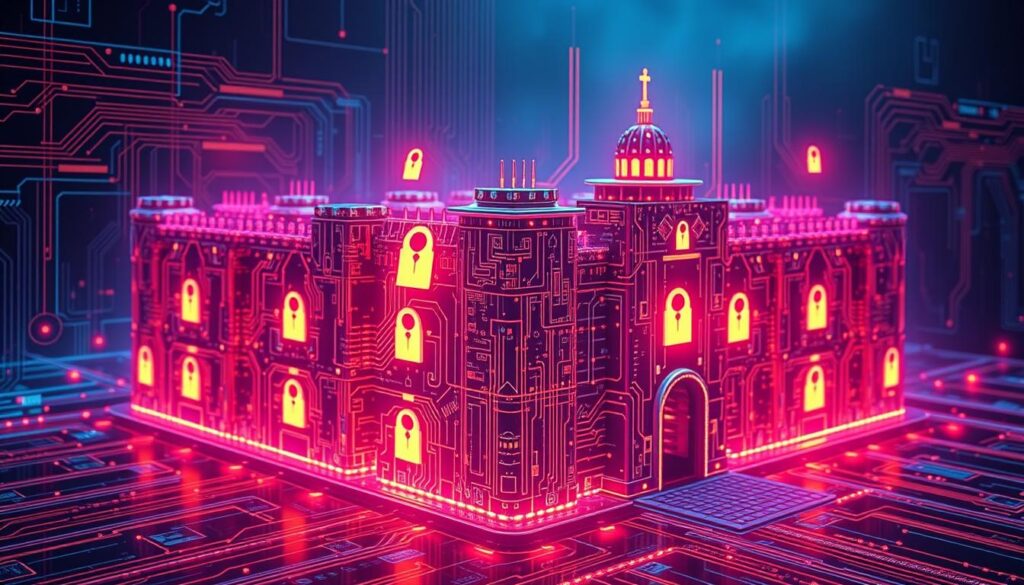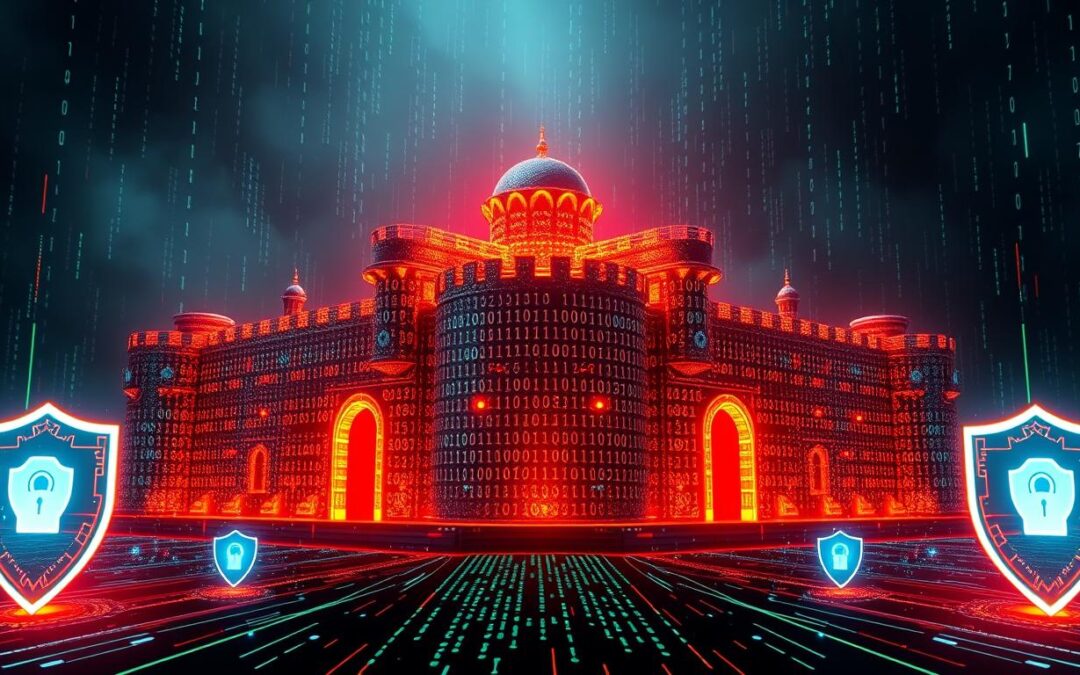Firewall protection is key to keeping your online activities safe from cyber threats. With more malware and ransomware attacks, having a strong firewall is crucial. It helps block unauthorized access and hacking, reducing cyber attack risks by up to 80%.
Complex networks can be broken down into smaller parts. This makes it easier for security teams to act fast when threats appear. Firewalls watch over traffic at network entry and exit points, boosting security. About 60% of small businesses have faced cyber attacks, showing how important firewalls are.
Firewalls control all network traffic coming in and going out. The average cost of a data breach for small businesses is about $2.98 million. This highlights the need for effective firewall protection to keep networks secure.
Key Takeaways
- Firewall protection can reduce the risk of external cyber attacks by up to 80%.
- Approximately 60% of small businesses report that they have experienced at least one cyber attack.
- Firewalls monitor and control traffic flow at network entry and exit points, enhancing network security.
- Firewall protection is essential for controlling 100% of incoming and outgoing network traffic.
- Approximately 90% of data breaches are caused by external attackers exploiting unsecured networks and systems.
- Firewall protection can block up to 95% of known threats from accessing a network.
Understanding the Fundamentals of Firewall Protection
Firewall protection is key in keeping networks safe. It checks and filters traffic based on set security rules. This stops unwanted access while letting in safe traffic. Firewalls can be physical or software-based, tailored to a network’s security needs.
Stateful inspection is a big part of firewall protection. It looks at network traffic’s context to check if it’s safe. This method is better than simple packet filtering because it catches more complex threats. Next-generation firewalls (NGFWs) go even further by adding integrated intrusion prevention systems (IPS) for quick threat detection and response.
There are also proxy firewalls and circuit-level gateway firewalls. Each has its own benefits and drawbacks. Choosing the right firewall depends on a network’s specific needs. Knowing how firewalls work helps protect against cyber threats and keeps networks secure.
Common Cyber Threats Prevented by Firewalls
Firewalls are key in stopping cyber threats like hacking, malware, and unauthorized access. They block certain traffic and let trusted sources in. Insider threats cause about 34% of data breaches, and DDoS attacks can hurt businesses a lot.
Keeping firewall firmware up to date can cut cyber attack risks by half. Next-generation firewalls (NGFWs) with Deep Packet Inspection (DPI) see 40% fewer spoofing attacks than basic methods. Firewalls offer many benefits, including:
- Stopping backdoor and denial-of-service attacks
- Protecting against malware and unauthorized access
- Lowering the risk of insider threats and data breaches
By setting up and managing firewalls right, companies can boost their network security. It’s vital to keep firewall configuration up to date for the best protection.
Using strong passwords, encrypting data, and backing up important info also helps fight cyber attacks. With these steps and good firewall solutions, companies can build a strong security system. This protects their networks and data.
Components of an Effective Firewall Solution
An effective firewall solution has several parts, including hardware and software. The hardware includes the firewall device, which can be a physical appliance or a virtual machine. A hardware firewall is a physical device, often part of a router, that sits between your network and the internet.
Firewall management and services are key to keeping a network safe. The software elements include the firewall software, which can be on the device or on computers. These work together to protect against cyber threats.
Hardware Components
Hardware components are the physical parts of a firewall solution. These can be part of a router or standalone devices. They filter network traffic based on security rules.
Software Elements
Software elements are the programs on the hardware. They give the firewall its smarts and ability to block threats. Keeping the software up-to-date is crucial for effective protection.
Integration Points
Integration points are where hardware and software meet. They’re vital for the components to work together well. Good management and services ensure these points are secure and working right.
Choosing the Right Firewall for Your Needs
Protecting your network is key, and picking the right firewall is essential. The right one depends on your network’s size, the traffic you need to guard, and how secure you want it. Network security is vital, and a good firewall can shield your business from cyber dangers.
A top best firewall for business should check network packet headers and filter traffic at the application layer. It should also use state data for better access decisions. Some firewalls have extra features like deep packet inspection, antivirus, and email spam scanning.
When picking a firewall, consider these points:
- Firewall throughput needs, which vary by business size
- The need for cloud-based firewall-as-a-service solutions for remote workforces
- The importance of managed firewall services for organizations lacking in-house security expertise

By thinking about these factors and picking the right firewall, you can keep your network safe. This protects your business from cyber threats.
Essential Firewall Configuration Steps
Setting up a firewall right is key to keeping your network safe. Firewalls check data coming in and going out based on rules. It’s important to set up the firewall and its basic settings correctly.
Creating rules is a big part of firewall setup. You need to make access control lists and set up network address translation (NAT). This helps manage private IP addresses in your network.
Initial Setup Process
The first step is to set up the firewall device. You need to configure basic settings. This includes using strong passwords for admin accounts and keeping firmware up to date.
Rule Creation Guidelines
When making rules, you’ll set up access control lists and NAT. It’s also important to test your firewall setup. This makes sure it’s working right.
Testing and Validation
Testing and checking your work are key steps. You need to test your firewall to see if it’s working. Then, you should check your setup to avoid security issues.
By following these steps, you can keep your network safe from cyber threats. Always update your firewall and test it to avoid security problems.
Some important stats to remember when setting up your firewall include:
- 80% of security breaches involve weak or stolen passwords
- 90% of organizations that deploy firewalls fail to regularly update firmware
- 60% of security incidents are caused by firewall rule failures
By focusing on firewall protection and cybersecurity, you can lower the risk of security breaches. This helps keep your network safe from cyber threats.
Advanced Firewall Features and Capabilities
Firewall software and solutions have grown to include advanced features. These include intrusion detection, virtual private networking, and encryption. Experts say next-generation firewalls offer better protection than older types.
Some key advanced features are:
- Intrusion detection and prevention
- Virtual private networking
- Encryption
- Application and identity-based policies
- Threat intelligence feeds integration
These features help organizations boost their security. They protect against complex cyber threats. Investing in strong firewall software and solutions keeps IT systems running smoothly and securely.
As more companies move to cloud-based systems, they need scalable firewalls. Advanced features help organizations stay safe from new threats. This ensures their networks remain secure and reliable.
Best Practices for Firewall Management
Effective firewall management is key to keeping your network safe. A good firewall policy can cut down network threats by up to 80%, as shown by industry benchmarks. Regular upkeep is vital to avoid security breaches, with 63% of breaches caused by weak or stolen passwords.
Companies that keep their firewall software up to date are 60% less likely to face a big data breach. Firewall configuration and firewall management are vital for a strong security plan. Firewalls can block up to 95% of unwanted traffic by default.
Regular Maintenance Tips
- Update firewall software and firmware regularly
- Monitor firewall logs to identify potential vulnerabilities
- Perform regular security audits to ensure compliance with organizational policies
By sticking to these best practices, organizations can keep their firewalls running smoothly. This helps prevent security breaches.
Update Procedures
Keeping your firewall software and firmware updated is crucial to avoid security breaches. Even a short delay can let cybercriminals exploit vulnerabilities. It’s wise to use a firewall change management platform for easy, automated testing.
Enterprise-Level Firewall Solutions
For businesses, having the best firewall is key to fight cyber threats. Enterprise firewalls have advanced features like intrusion detection and virtual private networking. They are made for big companies, offering strong protection against cyber attacks.
When picking firewall services, look at threat prevention, app inspection, and cloud support. Unified Security Management (USM) makes managing security policies easier. Top firewalls include the PA-Series by Palo Alto Networks, Cisco Secure Firewall, and Fortinet’s FortiGate.

Important features in enterprise firewalls are network segmentation and network access control. They also include remote access VPNs, email security, and web security. Data loss prevention and intrusion prevention systems help block malware and phishing attacks. The right firewall keeps networks safe from unauthorized access and harmful traffic.
Enterprise firewalls offer high-performance security, scalability, and easy management. AI-powered threat prevention is more effective than old methods. With more cyberattacks, getting the best firewall is vital for data protection and following laws like GDPR and HIPAA.
Common Firewall Implementation Mistakes to Avoid
Setting up a firewall is key to keeping an organization’s network security strong. Yet, mistakes during setup can weaken the firewall, making it easier for cybersecurity threats to get in. Studies show that using a centralized firewall management can cut down on mistakes by up to 30%.
One major mistake is making configuration errors. To avoid this, it’s best to block all traffic by default and only allow specific traffic to known services. Regular checks and tests can find and fix vulnerabilities, reducing them by 40-60%.
Security Gaps
Firewalls can have security gaps if they’re not set up right or kept up to date. Not updating firewall rules can leave networks open to 80% of new threats. Automatic updates can fix known issues in just 24 hours, much faster than manual updates.
Management Oversights
Management mistakes can also weaken a firewall. It’s important to keep an eye on firewall logs and act fast on any unauthorized access. Regular security audits are a must, especially when setting up a new firewall or making big changes.
By avoiding these common errors, organizations can keep their firewalls working well. This helps protect their network security and cybersecurity.
Some important stats to remember are:
- 60% of organizations say they’ve had a data breach because of firewall misconfigurations.
- 70% of network security issues come from not keeping firewalls up to date.
- 49% of IT pros don’t check and log firewall activity well enough.
Integrating Firewalls with Other Security Measures
Firewall protection is key to network security. Combining it with other security tools boosts protection. Firewall software works well with intrusion detection and antivirus. This combo helps catch complex threats like zero-day attacks and advanced malware.
Integrating firewalls with other security tools has many benefits. It makes networks more secure and better at handling traffic. It also prepares for future threats.
- Enhanced responsiveness to evolving threats
- Improved overall security effectiveness
- Optimized network traffic management
- Preparation for future threats
Experts say combining firewalls with intrusion prevention systems (IPS) cuts down attack risks.
Firewalls block many cyber threats, including advanced persistent threats (APTs) and insider attacks.
Integrating firewalls with other security tools needs careful planning. It involves setting clear security policies and making specific rules. Continuous monitoring is also key to keep everything running smoothly. By doing this, organizations can greatly improve their network security and lower cyber threat risks.
Measuring Firewall Performance and Effectiveness
It’s key to check how well firewall solutions work to keep your network safe. You should look at how many attacks are blocked, how much traffic is allowed, and how fast the firewall responds. These numbers help you see where you can make things better and improve your firewall configuration.
Doing regular checks on your firewall can find problems and outdated rules. This makes your network safer. Also, making your firewall solutions better can stop problems that slow down your network. A well-set-up firewall configuration means fewer security issues and less need for big changes.
To make your firewall solutions better, get rid of rules you don’t need and avoid duplicates. Use tools to automate this and regularly check your firewall configuration. This way, you can save money, make your network run smoother, and boost your security.
Conclusion: Maximizing Your Network Security Through Proper Firewall Implementation
In today’s world, cyber threats are getting smarter and more common. Firewalls are key to keeping your network safe. They block unauthorized access, malware, and data breaches.
By following the best practices in this guide, you can make your firewall work better. Regular firewall management and updates keep your network safe. This is important for firewall services in a changing world.
Remember, keeping your network safe is a never-ending job. Always watch for updates and changes in your firewall. This way, you can protect your data and keep your network secure.

